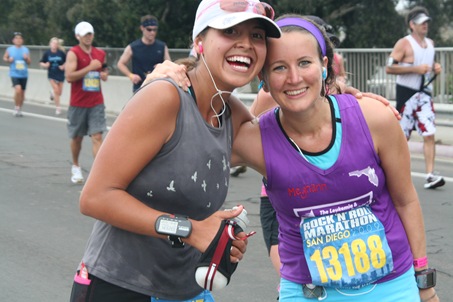A while back, I reached out to Meghann in hopes of some clarity around marathon training. Bo and I were trying to decide whether we needed to join a formal marathon training group/cause or whether we could train for the marathon as a couple without the power of a team.
Meghann is frequently a running inspiration for many bloggers and readers alike. She has gone from zero to hero in just a few short years. In fact, she ran her first 5k in March of 2008

Then, in June of 2009 she ran her first marathon with a little help from her friend and fellow blogger, Bobbi!!
My goal for the NYC 2010 Marathon is to be smiling this much during the last mile! Hopefully some of Meghann’s tips, tricks, and insight below will provide you with the same, great inspiration it gave me!
1) How long had you been a runner when you decided to train for a marathon?
I started running in January 2008 and began officially training for my first marathon in February 2009. So, I guess you can say I had been running for exactly a year before training for my first. J
2) What was the turning point or moment when you decided a marathon was your next race event?
The moment came when I volunteered for the Disney Marathon in January of 09. There was something about seeing all of the marathoners running by at mile 21 that really pumped my spirit. I figured if they could do it , then so I could I! I believe I registered for San Diego a week later. 🙂
Disney continued to hold a special place in my heart and I was thrilled to finally have my own chance to run it this past January. There was something about running the race that had inspired me to run my first marathon that just felt magical. It was as if life came full circle.
3) How many months did you have before the marathon?
I had 4 months to train before San Diego.
4) Did you train alone or with a group/cause/team? Did you ever consider training with a group/cause?
For my first marathon I trained with Team in Training in spirit. I raised all the money for Leukemia and Lymphona Society, but I never really ran with the group. Team in Training is set up for very beginner runners and they were training at a much different level than I was.
Though I was happy to raise money for a great cause through TnT, I wouldn’t train with them again. For Disney I was on my own.
5) When you trained alone, how did you put together a training plan? Is there a website or book you recommend for marathon rookies who are also training alone?
When I was on my own I took to google to create my training plan. I took an intermediate plan from Runners World and then reworked it to fit my needs. I had success with my marathon plan, but I’m not sure I would use it again. I think each marathon is different and each one requires a new approach with training.
6) Did you ever get lonely on your long runs since you weren’t training with a group? What tips do you have to help marathon rookies build up their mental "toughness"
I don’t mind long runs on my own. I always find gorgeous areas to run and zone out in my music and scenery. I also take the time to think about life. Having all that time to myself with my thoughts helps keep me sane. I would say the key to mental toughness is zoning out while getting lost in your thoughts.
7) How did you find motivation to stick with your training schedule even when you weren’t accountable to a running group?
The motivation came with knowing I had a marathon to run at the end of it! I was also motivated by time. I had a goal in mind and I was determined to beat it!
8) What, in your opinion, is the best aspect of training solo?
Not having to account on anyone else for training runs. You can run where you want and when you want. You can also run at what pace you want without having to worry about going to fast or slowing someone down.
9) What was the biggest lesson you learned during the training for your first marathon?
I learned to do more speed work. I did zero speed work while training for my first marathon and always regretted it because it meant I wasn’t training for my full potential.
10) What was the biggest lesson you learned on the course of your first marathon?
Not to give up and not to walk. Walking only makes things worse when you start to run again! They also weren’t kidding when they said miles 20-26.2 are a bitch!

If you’ve run a marathon..or 10 before and are interested in sharing some thoughts and insights please email me! I’d love to feature multiple marathoners during our training process to help all readers who are on their path to a healthier, happier life!
Thanks Meghann for all you support and inspiration!




